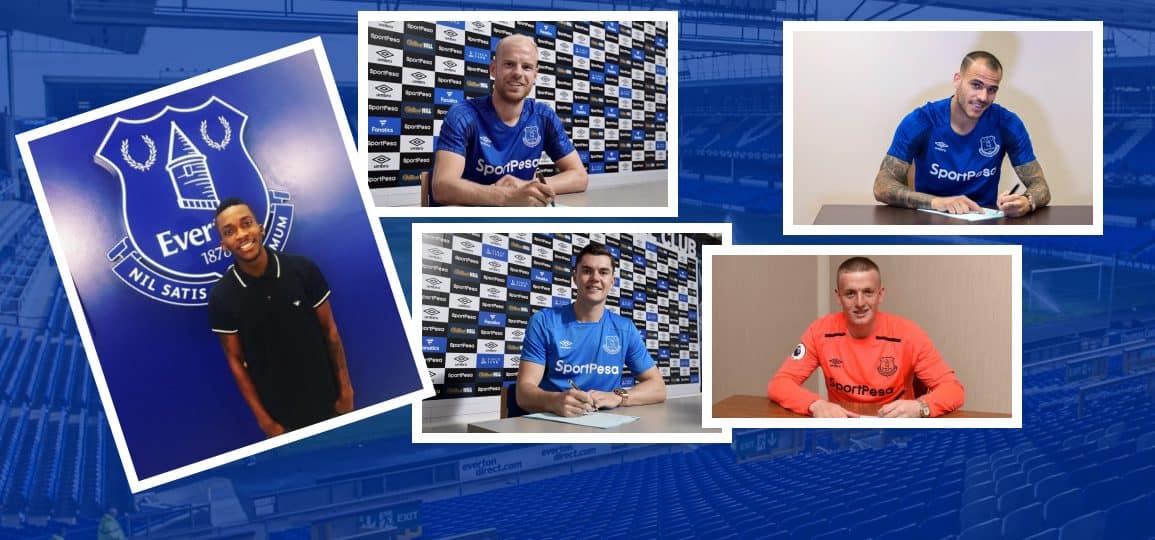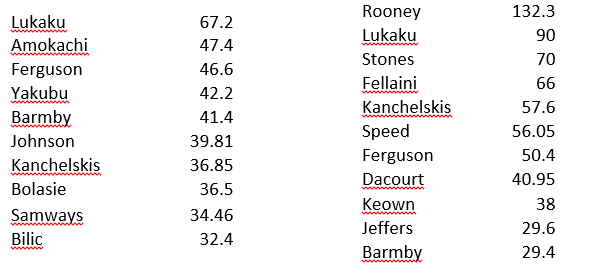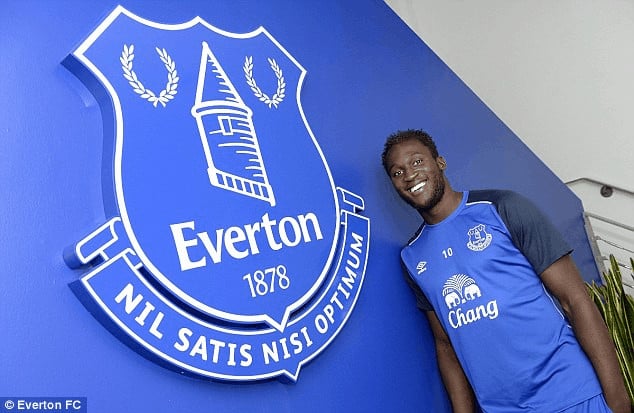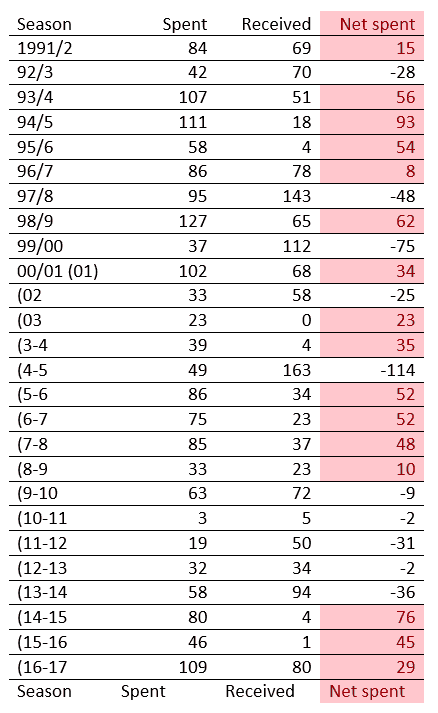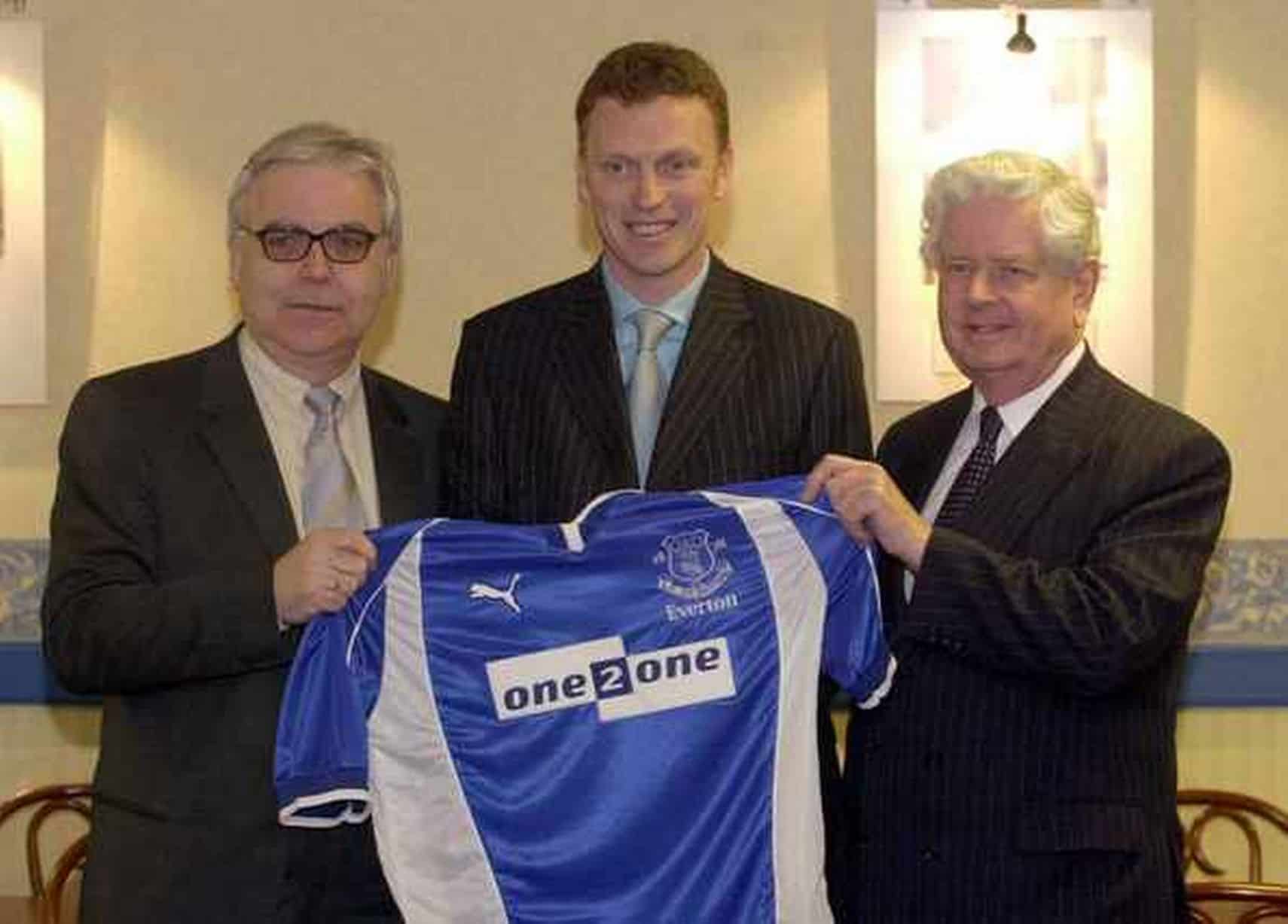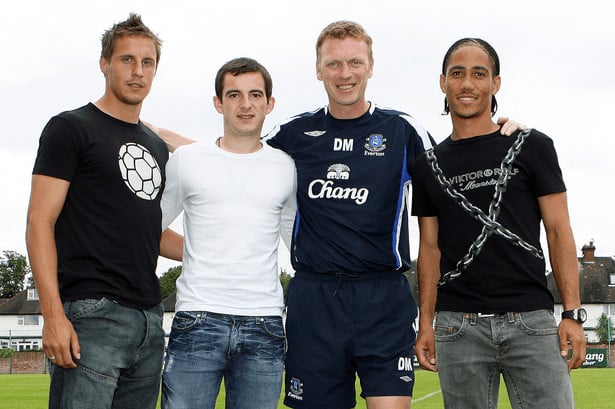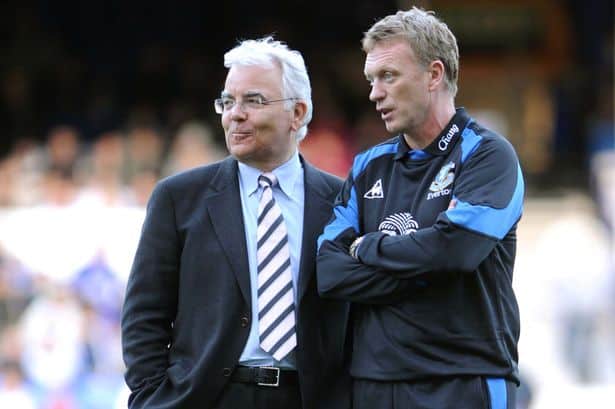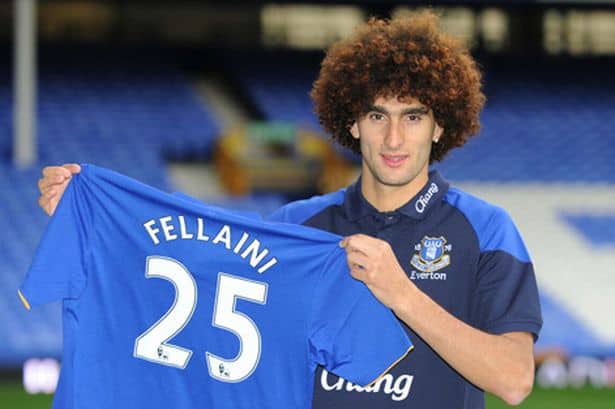Everton’s summer business looks set to break all it’s historical records.
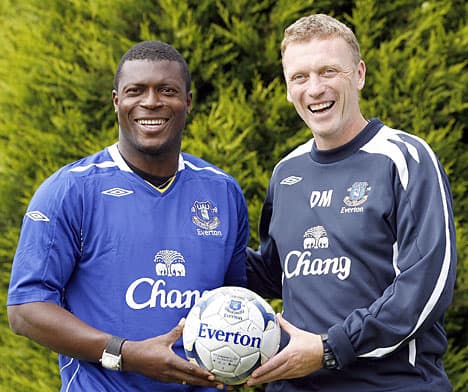 Before this summer the record fee spent on a player was 28 million for Romelu Lukaku which has been broken on 2 occasions already this summer with a third time looking likely and a 4th being far from improbable.
Before this summer the record fee spent on a player was 28 million for Romelu Lukaku which has been broken on 2 occasions already this summer with a third time looking likely and a 4th being far from improbable.
However in a league that is also spending record fees how can we place Everton on a matrix compared to other sides? How does this summers spend compare to Everton manager’s of years gone buy?
A maths guru Paul Tomkins has produced a model, based around looking at the value of each transfer in the Premier League to develop a model of inflation within football. Like with the outside world what he has noted is there has been inflation over the last 26 years of the Premier League. What is perhaps more startling is the inflationary pressure runs around 10 times the speed of the wider UK economy. Players now cost nearly 20 times more than they did at the start of the Premier League era, while CPI runs at about double. Using his analysis I have ascertained the 2017 value of each signing Everton have made in Premier League era. The gross and net spend season on season, and for each manager, to try and give some wider numerical context to Everton’s summer spending.
Before I share some of the results I should add in some caveats. Without seeking to take away from model which is the best (and I believe only) of it’s kind it should be noted that it seems heavily reliant on the British transfer market. I am unsure how he correlates the date with European transfers if at all. This is significant two levels. Firstly much of the spending in the 90’s was reflective of a league that was not the biggest spenders, whereas today increases in prices within the EPL are very much a world leader. The 90’s figures therefore may potentially be overhyped compared to the European market, while modern prices for EPL players may be slightly underestimated when we consider the relative lack of science of European spend. I am open to comment from anyone if they know how this is factored in. That withstanding though, it is a fantastic resource. I plugged the numbers in not knowing what to expect, and very much let the findings guide my conclusions.
What is the Football Inflation Rate (FIR)?
I hope people have followed my definition above of how it is calculated, by calculating average values of transfers between teams. Some general conclusions are;
1) The rate of FRI is around 10 times the figure of standard UK inflation. Footballers cost 19 times more, whereas most items only cost double.
2) There are 4 major periods of boom with 3 steadying periods. Periods of growth (1993-1996) (1999-2002) (2008-2010) and (2015-2017).
3) The biggest single growth appears to be 2008/09 with an increase of 76% (the summer Everton signed Fellaini).
4) The biggest single season of decline was 2002/3 (Moyes’s first full season in charge).
Key Everton Stats?
Everton have spent a total of 350 million pounds net (transfers minus sales) in todays money since the formation of the Premier League, across the 26 seasons I have data for. This works out at around 13.5 million pounds per season. In terms of gross spend this figure stands 1.8 billion or 67 million pounds per season.
Managers Joe Royle and Mike Walker got the best deal, Royle spending on average 36 million pounds per season net while Walker spent 51 million pounds in the two seasons he was partially involved for. The biggest loser was Kendall, his two spells saw a negative spend of 7 million in his first spell and 14 in his second (and this would have been less had I not included the hefty Bilic figure as part of his settlement). Smith had a negative spend of 1 million pounds per season while Moyes had a small positive spend of 6 million per season. Martinez came in at 29 million per season and Koeman currently stands at 13 per season (though likely to increase with the imminent purchase of Sigurdson and others).
In terms of overall transfers, Everton’s top ten sales and buys looks like;
One trend you see is that the range is far greater on the sales. Everton tend to sell fewer highly prized assets and tend to spend on a greater quantity of more mid range players. There have been 7 substantial sales in the Premier League for Everton worth 50 million plus. Only Lukaku really matches the above in terms of size. Interestingly Amokachi is a massively expensive asset like many others of the time was badly utilised.
The biggest net spend Everton had in a window was in 1994/5 (interestingly the previous season the awful 93/4 came third) at 93 million. The biggest amount recouped was 2004/5 down largely to the sale of Wayne Rooney, followed by 1999/2000. Full figures again below.
Reflections on Everton’s spend
1- Before Moshiri’s arrival Everton had increasingly fallen behind since the late 90’s.
There is little doubt that Everton had a really good go at spending big in the early 90’s. A period of 4 consecutive seasons of positive spending between 1993-1997 was something of a golden period for Everton under the guidance of local businessman Peter Johnson. The only comparable period of spending in Moyes from 2005/6 onwards for 4 years which will be considered more on the next point.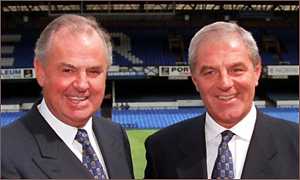
Players such as Kanchelskis, Fergusan (MK1) Limpar, Samways, Amokachi, Speed and Barmby were all brought up for upwards of 25 million in todays money. Nearly 30% of our most expensive 25 PL buys relate to this 4 years period and 50% of our top 10. We were rewarded with a cup win, though relegation dogfights in 1994, 95 and 97 ultimately signify this period as a missed opportunity for Everton.
The beginning of the end for this period began to be signified in early 1997. The sale of Kanchelskis (for 58 million in 2017) recouped some of what was spent yet the 10.5 million required for Tore Andre Flo manager Royle asked for wasn’t forthcoming. He ended up leaving the club, and the following season saw Evertons biggest net deficit since the Premier league began. In spite of some initial big spending the following summer, Fergusan was then sold in the autumn of 1999 and the following summer (2000) saw another net deficit of 75 million with Peter Johnson being driven out of the club and replaced by Bill Kenwright.
The years of 97-2002 represent a difficult period in terms of spending seeing the 5 year period culminate in a negative spend of 44 million pounds. There is instability at the top of the club tied too a period of inflation seeing costs increase by well over double between 1998-2002. Whereas the first boom in prices coincided with Everton spending heavily, the second boom sees Everton get left behind financially. Worryingly it was a sign of things to come over the next 15 years.
2- Kenwright and Moyes enjoyed a golden honeymoon period
I was somewhat surprised by the figures showing, particularly the early Moyes period. I’ve always felt Moyes had a very raw deal from Kenwright, but what looking at the figures show us is that at least initially they were a decent fit. The Premier League goes into it’s biggest decline in Moyes’s first summer in charge with prices dropping 27%. There are following declines of 15% and 10% in the next two years with only a modest increase of 2 & 5% for the years that followed that. Football players became cheaper to be.
For Everton, who were under the stewardship of a “millionaire not a billionaire’ Kenwright with the failed Kings Dock ground move and little chance of additional and much needed investment these years were a gift. Leeds United going into administration, and Portsmouth impending collapse led to enormous deflationary pressure. Likewise, Arsenal were focusing on a new Stadium Build, Liverpool and United were not spending wildly and with only Chelsea’s newly found billionaire’s money keeping any kind of growth solidity in the market. Looking back you do wonder how much more it could have slumped had their been no Abramovic?
For Everton though, a club who had already been left behind in the late 90’s these were good times. They would be able to pick up Martyn, Li Tie Kilbane, Jeffers, (on loan) and McFadden for little over 20 million pounds in todays money in 2004, while Yobo and Wright were brought in for under 40 million pounds in Moyes’s first summer.
The sale of Wayne Rooney for the equivalent of over 130 million in todays money bankrolled a further 3 years of spending (with net spends of 52, 52 and 48 million pounds). Players such as Cahill (9.8), Arteta, (9.8) Neville (17.15) Johnson (39.8), Lescott (18.5), Howard (13.9), Jagielka (15) & Baines (22.8) would be the sort of mid to low range signing Moyes became famed for as he built an infrastructure of a dependable and solid Premier League outfit.
A combination of a depressed market, a manager not overly keen on trading and able to rely caste offs or find bargains and hitting the jackpot of unearthing a lad who’d go onto be England’s greatest goalscorer made the initial 6 years of Moyes one where Everton were able to improve from a side regularly flirting with relegation to one which was solidly “best of the rest”.
The modest growth that occurred towards the end of the period (22% in 2008) had yet to really bite with the market in 2008 still to recover to the pre Moyes 2002 levels. Looking back on that time it really felt we were moving forward as a club with a young manager, well recruited players and a workable strategy. While there may have been frustration or pockets of discontent it wasn’t at the level of revolt that had been seen under the latter days of Johnson or the levels of protest which were to follow.
3- The third boom killed Kenwright’s Everton
If ever there was a perfect meeting of minds and purposes it was Moyes, Everton and 2003. A once great club was arrogantly sleepwalking to disaster. When he came in I remember being pleased, on the basis of if we went down he could get us back up. Such was the fear in those days. We had thrown money around like confetti in the mid 90’s with significant poor buys for big money, (Bakayoko, Amokachi, Bilic, Nyarko, Samways, Burrows etc). Smith who was used to using financial muscle to dominate a much weaker Scottish league was well out of ideas, and having stripped Everton’s youth team bear in sales to bring in reliable journeymen to keep us treading water, there was little long term prospects for improvement based on this model.
Moyes was something of a breath of fresh air on first entering. He openly said he didn’t want much money, just to be able to keep his players and buy a 5 million (around 20 million in todays money) player per season. A reasonable and achievable demand. Everton would stop the merryground of transfer under his watch, spend money more frugally and achieve a far better success rate. His willingness to work on the training pitch to improve players was also a welcome addition. A combination of his fiscal conservatism, prudence in the transfer market and keenness to adopt a mantra of improving within rather than seeking external recruitment solutions had molded us into a regular top 6 European contender.
The progress comes to something of an abrupt end in in 2008. There is the single greatest year if inflation on record in PL terms, with a growth of 76% largely underpinned by the Manchester City takeover. In the following years other clubs, such as West Ham, Aston Villa, Newcastle and others were sold on and would start spending sizeable sums for the loot of gold at the end of the champions league rainbow. Given we had been the closest to the champions league and suddenly couldn’t compete it was a galling time.
Everton simply get left behind at this moment. I would say there is little doubt there was complacency from those at the top of Everton, who had found football to be quite suitable for their liking with a method that worked. Imagine a links golfer who can hit the ball low, and straight for short distances and is happily progressing their game on that basis. Then overnight better equipment from others are bought and the courses is doubled in size. This was akin to the challenge that faced Everton who had become so familiar with their way of working they seemed incapable of switching methods.
The summer of 2008 was a disaster. Everton started the season with 2 teenagers involved Rodwell and Baxter in the starting 11, not strictly speaking on ability but due to lack of numbers. Only when the TV money came could we begin spending. In the end Andy Johnson would be sold to allow for Fellaini to come in, the only new signing of value that came in. 2008/9 was a warning shot of what was to follow, with the next 5 years Everton wracking up negative net spends.
The season after nobody was bought until Lescott was controversially sold after Moyes had made it clear he was not for sale. The following season only young players Gueye and Vellios or added, while the summer after only George Green and a handful of loans are added. Players such as Peinaar, Vaughan, Yakubu, Beckford and most painfully Arteta are sold during this period. Rather than selling to buy Everton are selling without buying, perhaps to compete.
As a club in 2008 we were ready to try and crack on to challenge the top 4 and it would have undoubtedly been Moyes’s ambition, however the initial growth and then consolidation of prices made the clubs approach unfeasible with further improvements. Looking back you can see the cynicism, anger and conservatism that would have crept into Moyes and he may look back and think he should have resigned after the Lescott sale.
4- TV Money and Moshiri re-invigorate Everton.
Positive net spends would follow with a sharp increase in TV revenue. Alongside this majority shareholder Farhad Moshiri comes to Everton at the end of the 2015/6 season and promises funds to spend. We look set for our biggest period of spending on record. This though should come with a word of warning- look to the mid 90’s. Without spending astutely you are not guaranteed any kind of success.
Concluding Remarks
Everton’s transfer this summer should be put into the wider context of the Premier League era. Sigurdsson at 50 million is not massively more expensive than Kanchelskis was for example. For the first time in a decade we are consistently getting names into our top 25 most expensive signings.
I also think we will again see more trading done. The amount spent and received goes down massively under Moyes, and I anticipate this will go up, as we embrace our ability to recruit and move players on.
I will attach the spreadsheet below with as much data as I have managed to complete. It’s not complete, but you could be able to see all the players on the list. Appreciate figures may not be entirely accurate, I used the Toffeeweb site and only changed figures when I was certain they were incorrect. As with most transfers there are debates as to the exact figure. Lukaku for example could be considered 75 million, 90 million or 100 million if you include the valuation of Rooney. Where possible I have tried to stick to the numbers provided by Toffeeweb for consistency.
[embeddoc url=”http://www.grandoldteam.com/wp-content/uploads/2017/08/Transfervalues.xlsx” download=”all” viewer=”microsoft”]


